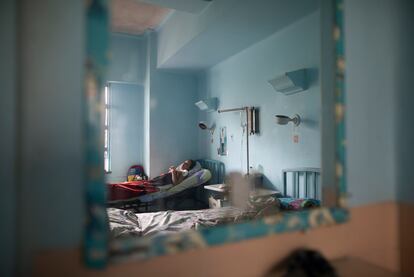Cancer attacks Latinos differently: They are more susceptible to cervical cancer and less to breast cancer
Socioeconomic, cultural and language barriers imply a greater predisposition to contracting certain forms of the disease, particularly those caused by infectious processes. It also makes access to effective treatments difficult


When Ysabel Duron, a Californian by birth whose father is Mexican, went in for her annual gynecological check-up in 1999, she did not suspect that she had cancer. But, as is often the case, the disease had progressed stealthily and unnoticed. They found Hodgkin’s lymphoma in an unusual place: the pelvis. To continue treatment, she was referred to one of the best specialists at Stanford, “the godfather of Hodgkin’s,” as Duron calls him. The treatment was effective and the cancer disappeared. “Mine was a luxury case. I was able to communicate. I had great health insurance. And I was treated by the best doctor at Stanford, whom I could go to without problems,” she admits. While in treatment, “I looked around the room and asked myself: Where are the Latinas?” This is how she changed a long career as a television journalist and dedicated herself to helping women of Hispanic origin fight the disease. To this end, she founded the organization Latinas Contra el Cancer (Latinas Against Cancer). From this vantage point, she was able to confirm that there are many factors involved, including cultural, genetic and socioeconomic ones, that determine the fact that Latinos are more prone to contracting certain types of cancer.
“Hispanics are less likely to be diagnosed with the four most common types of cancer (lung, colon, breast and prostate). On the contrary, they are more prone to contracting liver, stomach and cervical cancer. These have in common that they are related to infections, such as the human papillomavirus,” says Dr. Lynne Padgett, from the National Institute on Minority Health and Health Disparities.
When there is a diagnosis, the kind of “luxury” enjoyed by Duron, who is currently continuing her work from The Latino Cancer Institute, is not the case for the majority of Latina women who need to get cancer treatment. The starting point is their lack of health insurance. Among people ages 18 to 64, 26% of Hispanics were uninsured during 2017-2018 compared to 9% of non-Hispanic whites, according to the American Cancer Society.
Regarding the genetic factor, if Latinos have a higher probability of contracting cervical cancer, it also makes them less vulnerable to breast cancer because “their Indigenous heritage protects them,” explains Alejandra Hurtado de Mendoza, assistant professor in the department of cancer prevention at Georgetown University in Washington. “Also the fact that Latina women have children at younger ages and breastfeed. These are protective factors that reduce the risk of suffering from breast cancer, but they are being lost among those who are born here and adopt behaviors that may be more risky, such as a less healthy diet, having fewer children...,” she adds.

Acculturation increases risk
The risk of cancer increases for Latinos with acculturation. Immigrants to the United States and subsequent generations may engage in unhealthy behavior, especially consuming a lower quality diet. The average body mass index among Mexicans is highest among those born in the United States, intermediate among foreign-born long-term residents, and lowest among foreign-born people who have lived in the country less than 15 years.
One study found that overall cancer death rates in Texas for U.S.-born Latino men were about 60% higher than those born abroad, according to the American Cancer Society. Likewise, the adoption of a diet based on ultra-processed foods and fast food has caused a dangerous increase in obesity, which, in turn, is a determining factor in cervical cancer, the incidence of which in Hispanic women is approximately 30%-40% higher than in non-Hispanic white women.

Prevention is essential to detect this type of cancer in time, and Latinas face numerous barriers: the lack of resources to pay for insurance, the lack of habit of going to the doctor without being sick, the inability to be absent from work, the language, family obligations... “Cervical cancer prevails among Latinas due to lifestyle, socioeconomic factors and a biological predisposition. After 23 years, we are still trying to tackle the most basic thing, which is for them to go in for preventive exams,” Duron acknowledges.
“There are many cultural barriers. We don’t go to the doctor until we are sick and the family’s needs come first. The serious thing is that when they come they already have advanced cancer,” says Astrid Jiménez, director of Nueva Vida, an organization that supports Latinas with cancer and operates in Maryland, Washington D.C. and Virginia. The non-profit organization was founded 25 years ago by an Argentine psychiatrist, a Chilean psychologist and a Colombian economist. “The three of them had cancer and they had it so bad that they thought about what it must be like for those who did not have access to quality medical services like themselves, without family and without speaking English,” says Jiménez. Their job is to educate them, provide them with preventive examinations and medical treatments, accompany them throughout the process, serve as translators, and help them obtain financing. But above all, they provide moral support. “It is extremely important. With this disease, not only does the body decline, but so does the emotional side,” explains Jiménez.
Ana Navas, a Salvadoran woman who lives in the state of Virginia, went to Nueva Vida when she found out she had breast cancer. “It started as a skin discomfort. I went to the doctor at the community clinic and he gave me a cream. I wanted me to have a mammogram, because I knew something was wrong with my body, but I couldn’t cover the expenses,” she recalls. In Nueva Vida, they accompanied her on medical visits and gave her financial help for basic needs because she had to stop working. But what she values most “is the emotional support, which is the most difficult thing to get. Knowing that you are not alone, because you don’t speak the language and you don’t have a family,” she explains. Navas got treatment and the cancer is in remission.
“It is very difficult to navigate this health system, especially if they have language barriers. The role of community organizations and navigators is absolutely fundamental,” says Hurtado de Mendoza. These navigators are the people who accompany the patients throughout the entire process, serving as translators and identifying the needs they have as the disease and treatment progress.
Claudia Colindres worked as a navigator at Latinas Contra el Cancer for 11 years. Coming from Honduras, a year after arriving in the United States in 2005, her four-year-old daughter was diagnosed with leukemia and she was able to see that navigating the health system is very complicated. That’s why she used her experience to help other Latina patients at an oncology clinic in San José, California. “A big barrier is language. I went to the doctors and translated for them. And I also explained to the families what medications they needed, what treatments. This way, the doctor was sure that they understood him. Sometimes I saw discrimination from medical staff and nurses because they didn’t speak English,” she recalls.
Colindres also says that she encountered many cases of sexism, where the woman’s partner did not understand the difficult situation and the woman had to continue taking care of the children and even working if she was the only person who contributed income to the family. Speaking from the same organization, Jiménez also criticizes the sexist attitudes that they have encountered when trying to contact some patients. “Sometimes the husband answers the phone and asks why we want to talk to the wife, that he knows everything and can answer for her. The navigators are already experts at this and ask the man when his partner’s last menstruation was. So they have no choice but to pass the phone to the interested party,” she says.
Navigators also have to deal with misconceptions and myths about cancer, such as believing that a diagnosis is a death sentence, so those affected do not share the information with others. This lack of information is a problem when researching genetic factors, which Hurtado de Mendoza studies. “It is very important for us because we have to know the family history and many do not know it because it is not talked about openly,” she points out.
The lack of data partly explains why Latinos are rarely present in research studies. Researchers and patient advocates also complain that everyone is lumped together, when it would be necessary to disaggregate, given the differences in origin, socioeconomic and cultural level, and other factors that influence predisposition to the disease. Furthermore, they are not well represented among medical staff, where only 5% are Hispanic despite the fact that Latinos already make up almost 20% of the total population. “Several Latino colleagues from the academic and research world and I have been defending for more than a decade that population data must be disaggregated because Latinos in the United States are a diaspora,” Duron points out.
Sign up for our weekly newsletter to get more English-language news coverage from EL PAÍS USA Edition
Tu suscripción se está usando en otro dispositivo
¿Quieres añadir otro usuario a tu suscripción?
Si continúas leyendo en este dispositivo, no se podrá leer en el otro.
FlechaTu suscripción se está usando en otro dispositivo y solo puedes acceder a EL PAÍS desde un dispositivo a la vez.
Si quieres compartir tu cuenta, cambia tu suscripción a la modalidad Premium, así podrás añadir otro usuario. Cada uno accederá con su propia cuenta de email, lo que os permitirá personalizar vuestra experiencia en EL PAÍS.
¿Tienes una suscripción de empresa? Accede aquí para contratar más cuentas.
En el caso de no saber quién está usando tu cuenta, te recomendamos cambiar tu contraseña aquí.
Si decides continuar compartiendo tu cuenta, este mensaje se mostrará en tu dispositivo y en el de la otra persona que está usando tu cuenta de forma indefinida, afectando a tu experiencia de lectura. Puedes consultar aquí los términos y condiciones de la suscripción digital.
More information
Archived In
Últimas noticias
Maduro counterattacks Trump with rhetoric and announces downing of nine drug trafficking aircraft
‘Ecce Homo’: The miraculous disaster that made a small Spanish town famous
Return to sex testing at the Olympics: IOC edges closer to banning transgender women
Trump escalates conflict with Venezuela with the start of covert operations
Most viewed
- Sinaloa Cartel war is taking its toll on Los Chapitos
- Oona Chaplin: ‘I told James Cameron that I was living in a treehouse and starting a permaculture project with a friend’
- Reinhard Genzel, Nobel laureate in physics: ‘One-minute videos will never give you the truth’
- Why the price of coffee has skyrocketed: from Brazilian plantations to specialty coffee houses
- Silver prices are going crazy: This is what’s fueling the rally










































